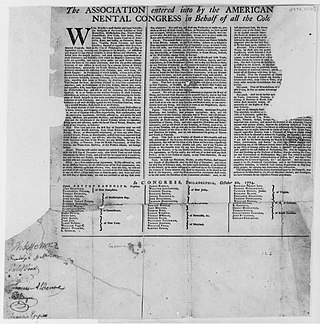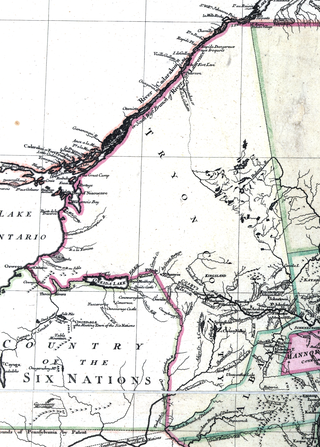Related Research Articles

The American Revolutionary War, also known as the Revolutionary War or American War of Independence, was the military conflict of the American Revolution in which American Patriot forces under George Washington's command defeated the British, establishing and securing the independence of the United States. Fighting began on April 19, 1775 at the Battles of Lexington and Concord. The war was formalized and intensified following passage of the Lee Resolution, which asserted that the Thirteen Colonies were "free and independent states", and the Declaration of Independence, drafted by the Committee of Five and written primarily by Thomas Jefferson, by the Second Continental Congress in Philadelphia, on July 2, 1776 and July 4, 1776, respectively.
Tryon County is a former county which was located in the U.S. state of North Carolina. It was formed in 1768 from the part of Mecklenburg County west of the Catawba River, although the legislative act that created it did not become effective until April 10, 1769. Due to inaccurate and delayed surveying, Tryon County encompassed a large area of northwestern South Carolina. It was named for William Tryon, governor of the North Carolina Colony from 1765 to 1771.

Robert Howe was a Continental Army general from the Province of North Carolina during the American Revolutionary War. The descendant of a prominent family in North Carolina, Howe was one of five generals, and the only major general, in the Continental Army from that state. He also played a role in the colonial and state governments of North Carolina, serving in the legislative bodies of both.

The Continental Association, also known as the Articles of Association or simply the Association, was an agreement among the American colonies adopted by the First Continental Congress on October 20, 1774. It called for a trade boycott against British merchants by the colonies. Congress hoped that placing economic sanctions on British imports and exports would pressure Parliament into addressing the colonies' grievances, in particular, by repealing what were referred to as the Intolerable Acts.

Adam Frederick Helmer, also known as John Adam Frederick Helmer and Hans Adam Friedrich Helmer, was an American Revolutionary War hero among those of the Mohawk Valley and surrounding regions of New York State. He was made nationally famous by Walter D. Edmonds' popular 1936 novel Drums Along the Mohawk with its depiction of "Adam Helmer's Run" of September 16, 1778, to warn the people of German Flatts of the approach of Joseph Brant and his company of Indians and Tories.

The committees of correspondence were, prior to the outbreak of the American Revolutionary War, a collection of American political organizations that sought to coordinate opposition to British Parliament and, later, support for American independence. The brainchild of Samuel Adams, a Patriot from Boston, the committees sought to establish, through the writing of letters, an underground network of communication among Patriot leaders in the Thirteen Colonies. The committees were instrumental in setting up the First Continental Congress, which met in Philadelphia.

The Suffolk Resolves was a declaration made on September 9, 1774, by the leaders of Suffolk County, Massachusetts. The declaration rejected the Massachusetts Government Act and resulted in a boycott of imported goods from Britain unless the Intolerable Acts were repealed. The Resolves were recognized by statesman Edmund Burke as a major development in colonial animosity leading to adoption of the United States Declaration of Independence from the Kingdom of Great Britain in 1776, and he urged British conciliation with the American colonies, to little effect. The First Continental Congress endorsed the Resolves on September 17, 1774, and passed the similarly themed Continental Association on October 20, 1774.
In the American Revolution, committees of correspondence, committees of inspection, and committees of safety were different local committees of Patriots that became a shadow government; they took control of the Thirteen Colonies away from royal officials, who became increasingly helpless.
What is known today as the Tryon Resolves was a brief declaration adopted and signed by "subscribers" to the Tryon County Association that was formed in Tryon County, North Carolina in the early days of the American Revolution. In the Resolves—a modern name for the Association's charter document—the county representatives vowed resistance to the increasingly coercive actions being enacted by the government of Great Britain against its North American colonies. The document was signed on August 14, 1775, but—like other similar declarations of the time—stopped short of calling for total independence from Britain.

Guy Johnson was an Irish military officer and diplomat. He served on the side of the British during the Revolutionary War, having migrated to the Province of New York as a young man and worked with his uncle, Sir William Johnson who served as the British Superintendent of Indian Affairs of the northern colonies.

The First Continental Congress was a meeting of delegates from 12 of the 13 British colonies that became the United States. It met from September 5 to October 26, 1774, at Carpenters' Hall in Philadelphia, Pennsylvania, after the British Navy instituted a blockade of Boston Harbor and the Parliament of Great Britain passed the punitive Intolerable Acts in response to the December 1773 Boston Tea Party. During the opening weeks of the Congress, the delegates conducted a spirited discussion about how the colonies could collectively respond to the British government's coercive actions, and they worked to make a common cause.
The North Carolina Provincial Congresses were extra-legal unicameral legislative bodies formed in 1774 through 1776 by the people of the Province of North Carolina, independent of the British colonial government. There were five congresses. They met in the towns of New Bern, Hillsborough (3rd), and Halifax. The 4th conference approved the Halifax Resolves, the first resolution of one of Thirteen Colonies to call for independence from Great Britain. Five months later it would empower the state's delegates to the Second Continental Congress to concur to the United States Declaration of Independence. The 5th conference approved the Constitution of North Carolina and elected Richard Caswell as governor of the State of North Carolina. After the 5th conference, the new North Carolina General Assembly met in April 1777.
The New York Provincial Congress (1775–1777) was a revolutionary provisional government formed by colonists in 1775, during the American Revolution, as a pro-American alternative to the more conservative New York General Assembly, and as a replacement for the Committee of One Hundred. The Fourth Provincial Congress, resolving itself as the Convention of Representatives of the State of New York, adopted the first Constitution of the State of New York on April 20, 1777.
James Moore was a Continental Army general during the American Revolutionary War. Moore was born into a prominent political family in the colonial Province of North Carolina, he was one of only five generals from North Carolina to serve in the Continental Army. He spent much of his childhood and youth on his family's estates in the lower Cape Fear River area, but soon became active in the colonial military structure in North Carolina.
Joseph Hardin Sr. was an Assemblyman for the Province of North Carolina, and was a signatory of the Tryon Resolves. Early in the War for Independence, as a member of the militia from Tryon County, Hardin fought the Cherokee allies of Britain along the western frontier. Later in the war, having taken his family over the Appalachian Mountains to the Washington District for safety against the advance of the Red Coats out of South Carolina, Hardin joined the Overmountain Men. He saw action at the Battle of Ramsour's Mill and the decisive Battle of Kings Mountain. Following the peace with Britain, Hardin was a co-founder and second Speaker of the House for the State of Franklin; and an Assemblyman in the Southwest Territory before its statehood as Tennessee.
The Province of Georgia was a significant battleground in the American Revolution. Its population was at first divided about exactly how to respond to revolutionary activities and heightened tensions in other provinces. When violence broke out in 1775, radical Patriots took control of the provincial government, and drove many Loyalists out of the province. Georgia also served as the staging ground for several important raids into British-controlled Florida.

Tryon County was a county in the colonial Province of New York in the British American colonies. It was created from Albany County on March 24, 1772, and was named for William Tryon, the last provincial governor of New York. The county's boundaries extended much further than any current county. Its eastern boundary with the also-new Charlotte County ran "from the Mohawk River to the Canada line, at a point near the old village of St. Regis and passing south to the Mohawk between Schenectady and Albany." It extended north to the St. Lawrence River; its western boundary was the Treaty of Fort Stanwix's Line of Property, following the Unadilla River, Oneida Lake, Onondaga River and Oswego River to Lake Ontario, as the Iroquois Confederacy still controlled locations further west in the Indian Reserve. Tryon County's seat was Johnstown, which is today the county seat of Fulton County. The Tryon County Courthouse, built in 1772–1773, was listed on the National Register of Historic Places in 1972. The Tryon County Jail, also built in 1772–1773, was listed on the National Register of Historic Places in 1981.
The Rowan County Committee of Safety was one of the 18 Committees of Safety in North Carolina authorized by the Continental Congress and endorsed by the Second North Carolina Provincial Congress. It was established in Rowan County, North Carolina in 1774. Meeting minutes from 1774 to 1776 have survived and are available through a digital collection. The Rowan County Committee of Safety was instrumental in banning trade with Britain and preparing for the American Revolution. One of its major achievements was the Rowan Resolves.
References
- ↑ Carolina.com "Tryon County, North Carolina History"; by Alfred Nixon; 1910